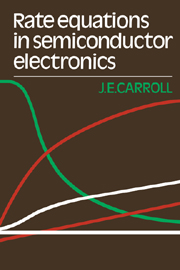Book contents
- Frontmatter
- Contents
- Preface
- 1 Introduction to rate equations
- 2 Elementary rate equations in semiconductors
- 3 Rates of switching
- 4 Rates of change and transfer in phase space
- 5 Rate equations in quantum electronics
- 6 Rate equations in optoelectronic devices
- 7 Advanced topics in rate equations
- Appendix A Counting states
- Appendix B Notes on differences between gas and diode laser rate equations
- Notes on solutions
- References
- Index
1 - Introduction to rate equations
Published online by Cambridge University Press: 04 December 2009
- Frontmatter
- Contents
- Preface
- 1 Introduction to rate equations
- 2 Elementary rate equations in semiconductors
- 3 Rates of switching
- 4 Rates of change and transfer in phase space
- 5 Rate equations in quantum electronics
- 6 Rate equations in optoelectronic devices
- 7 Advanced topics in rate equations
- Appendix A Counting states
- Appendix B Notes on differences between gas and diode laser rate equations
- Notes on solutions
- References
- Index
Summary
Introduction
An outstandingly innovative scientist, Rudi Kompfner, wrote that when his intuition was unengaged or disengaged then his creative faculties were paralysed. Although Kompfner was writing about quantum theory, his remarks apply to most aspects of science. How can one create and innovate when no understanding is present? The idea behind this book is that a useful contribution to understanding in science and engineering can be found by determining the rate at which an interactive process occurs and concentrating on the dominant features which limit the interaction rates.
Such thinking is not limited to science; it can have universal application. For example, before lending money to a client, a building society will ask how much that client is earning from any employers, and so obtain an estimate of the maximum rate at which the client can reasonably pay off the mortgage that will be advanced to buy a house. The rate of income being paid to the client determines to a first order the rate at which money can be spent! The maximum amount of traffic that can use a road may be limited not by the size of the road, but by the rate at which traffic can escape or enter from congested roundabouts that serve the road. In building electronic circuits to switch at high speeds, one may find that the speed is limited by the rate at which components can transfer charge into a capacitive load. It may alternatively be limited by the rate at which information can be transmitted from neighbouring devices, which have to be a certain distance away in order to accommodate enough devices to drive and be driven by any one single device.
- Type
- Chapter
- Information
- Rate Equations in Semiconductor Electronics , pp. 1 - 15Publisher: Cambridge University PressPrint publication year: 1986

